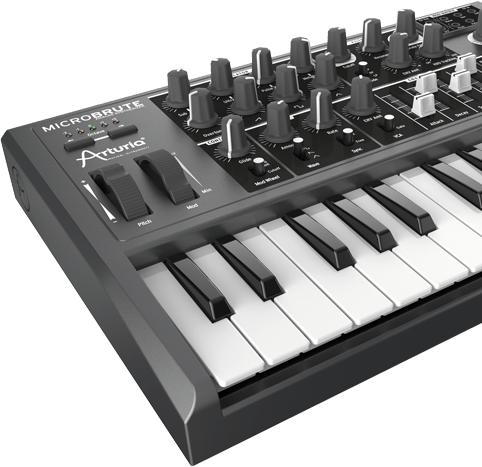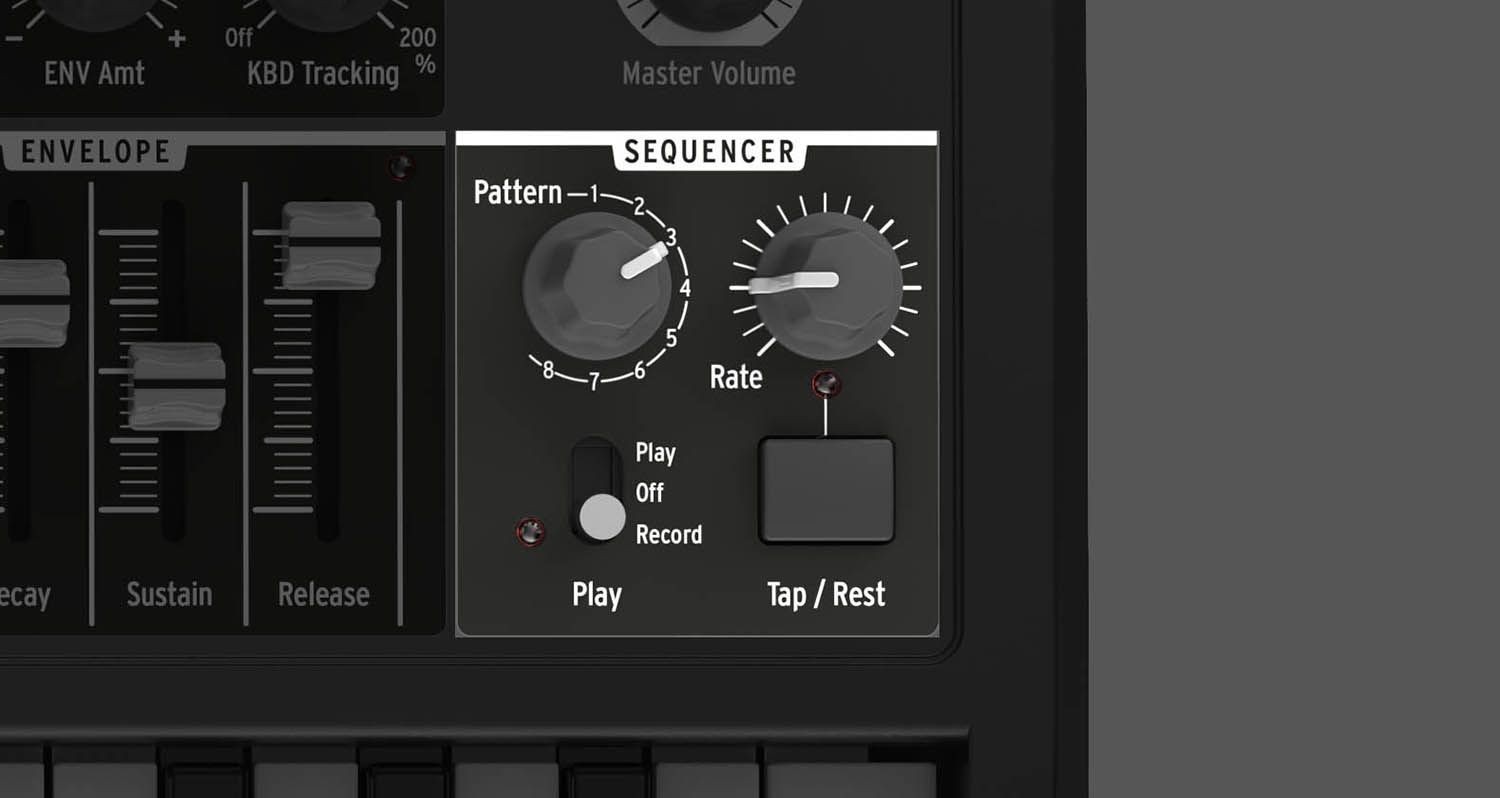Takes your sound
to a new level
The MicroBrute is new but carries the award-winning heritage of its big brother, the MiniBrute.
The MicroBrute was designed to be small but still retain an amazing sound quality. With a 100% pure analog voice path and advanced interconnectablity via MIDI, USB, CV/GATE, this machine is a true powerhouse synthesizer.

The largest
Oscillator sound around
VCO
The VCO on the MicroBrute is unique in the synthesizer world. It features the ability to mix waveforms in variable amounts as opposed to simple ON/OFF switches that are found on many synths at four times the price. The sound possibilities don’t stop there. Each waveform has wave modifiers that allow even further tonal variations. While many synths need two or three oscillators to get a somewhat big sound, the MicroBrute is able to achieve a much wider tonal range with its one oscillator.
pulse wave
Overtone
For the MicroBrute we redesigned our sub-oscillator from the ground up. The new OVERTONE sub allows for the typical -1 octave square wave that thickens up the bottom end but goes beyond this with the Overtone control. The Overtone control allows you to bring in more complex harmonics that when turned all the way up result in the oscillator changing pitch to a 5th above the root. This allows for some classic sounding leads and fatter basses. This control can even be modulated with the ENVELOPE or LFO via the mod matrix which creates some amazing new sounds never heard from a synth oscillator before.
overtone 1
overtone 2
overtone 3
overtone 4
Ultrasaw
The Ultrasaw builds two phase-shifted copies of the basic sawtooth signal. This effect, when turned up, gives you a slight thickening of the sound as it duplicates the sound of two saw oscillators close to the same pitch. You can then use the MOD MATRIX to route the LFO to the SAW which will add a third saw sound and allow you to simulate a wider detuning effect. This one saw wave can now sound like a three-oscillator synth by itself.
ultrasaw2
Metalizer
The Metalizer takes the basic triangular waveform and “warps/folds” it to create very complex jagged waveforms that are rich in high harmonics. This results in a hard sync sweep type of sound that is perfect for hardcore bass sounds or tearing leads. The ENVELOPE has a default routing to this parameter via the MOD MATRIX. Just turn up the ENVELOPE amount control, adjust your envelope to an interesting setting and you will hear the effect take hold.
tri1
tri2
tri3
Modulation
Beast
The MicroBrute comes with a full-featured LFO and a standard ADSR type envelope. The routing of these modulation sources are configured in the MOD MATRIX. No other synth in this price range allows for this kind of flexibility.
The MOD MATRIX allows you to control many aspects of the voice for different internal sources as well as opening the door to controlling them by external synths and modules. The MOD MATRIX has two default routings:
- ENV > METALIZER
- LFO > PITCH
This allows you the typical LFO/MODWHEEL vibrato control as well as having the envelope add modulation to the Metalizer.
Note that the ENV is always routed to the filter and there is a separate ENV AMOUNT control in the filter itself. This default routing can be overridden by simply inserting one of the patch cords into either the mod output or input jacks. You can then patch in your own routings.
The mod wheel allows for manual control of either the filter cutoff or the LFO amount. This allows you to play the modulation in real time, adding character and interest to your musical passage.
A standard ADSR (Attack, Decay, Sustain, Release) envelope can be used for controlling the filter cutoff and the amplitude directly. You can then patch the output via the mod matrix and use the AMOUNT control to affect the pitch, Metalizer, pulse width or any other control destination in the MOD MATRIX.
Steiner-Parker
Filter
So what does MicroBrute sound like?
MicroBrute embeds the legendary Steiner-Parker multimode filter.
Introduced for the first time in the Synthacon synthesizer back in the 70’s, this marvelous filter not only gives you a Lowpass mode like most other synths, but also Bandpass and High-pass, making it a highly versatile and acclaimed boutique filter.
The MicroBrute filter is based on the core of the legendary Steiner-Parker multimode filter and has been enhanced to deliver an even wider range of cutoff and resonance. Nyle Steiner himself has validated and approved these enhancements.
Many synths at well over twice the price of MicroBrute come with only a single low pass filter and many modular synth companies sell their version of this classic filter for more than the total price of the MicroBrute.
Audio In Demo
Pierce Warnecke
In this example, a drum loop is processed through MiniBrute’s Filter and VCA circuit using the audio input while playing a classic acid-style bass.
bpf1
hpf1
lpf1
Brute
Factor™
The Brute Factor™ was inspired by a patch made on a famous vintage synthesizer.
Users would connect the headphone output to the external audio input, resulting in a kind of feedback loop that is ideal for raspy and grungy sounds. This patch has been adapted and implemented internally first in the MiniBrute and now in the MicroBrute.
With low Brute Factor™ settings, you will hear a gradual depth and roundness to the bottom end. When turned up above about 65% however, the MicroBrute can go berserk and produce barely controllable, crazy feedback sounds.
Note: the Brute Factor™ feature alters the filter characteristics, so expect highly unpredictable results at extreme settings. You have been warned!
Microbrute
as an Audio Processor?
MicroBrute is more than a synthesizer.
It allows a return to audio experimentation by giving you the ability to process external sounds through it. The MicroBrute has an audio input with a pop-up trim pot for level controls on the rear panel. This will allow you to process any other sounds like voice, guitar or other synths through the MicroBrute’s filter, Brute Factor™, and final output stages.
ddrum process bip
Step
Sequencer
We have added a new step sequencer for the MicroBrute. The step sequencer hearkens back to some other step sequencer designs of the ‘80s, but updates them in a way that goes beyond belief.
The step sequencer allows for eight different sequences. These sequences can have up to 64 steps each and are stored in internal memory so that when you power down, they are retained.
You input the notes that you want one at a time and can insert rests using the TAP TEMPO button to create rhythmic patterns. Once you have your sequences, you can choose between many different ways to trigger and play them.
Note On or Continuous Play modes allow you to choose whether the sequence will only play when a key is pressed or to start immediately when the control switch is moved to PLAY.
When you change sequences while playing you can specify whether the new sequence will play immediately or wait until the end of the current sequence before changing.
There are even more controls accessible via the free editor software that allow you to tailor the sequencer to your working style.
So what happens once you have your eight sequences and you want to make more, but you don’t want to lose your current sequences? Simple. Using the editor software you can import and export your sequences to your computer for archiving.
Connectivity

_1
_2
_3
01. CV/Gate
MicroBrute supports the standard 1 Volt per octave format found on most modern modular synthesizers, and also on the MiniBrute. This makes the MicroBrute a great addition to both modular users and MiniBrute users.
MiniBrute users can have the sequencer of the MicroBrute drive the MiniBrute via CV/GATE. They can use the envelope and LFO CV outputs to add a third env and LFO to your MiniBrute via the Filter, Pitch or VCA inputs.
Modular users can use the MicroBrute's sequencer, keyboard, envelope and LFO to add a vast amount of functionality to their modulars. It typically costs more money to purchase a Steiner-Parker filter module, not to mention the other controls that MicroBrute offers.
02. Audio IN
Processing of external audio sources is possible with the audio input.
You can run your drums through the MicroBrute's filter and Brute Factor™. Shape the sound or modulate a vocal part. Use the external input along with a sequence that is modulating the filter to get some great rhythmic tonal changes to a guitar solo or bass line. The possibilities are endless.
03. MIDI/USB
The MicroBrute allows full connectivity to the modern world. The vast majority of the new low-cost analog products are lacking this critical functionality, which relegates them to the toybox and not the professional studio.
The MicroBrute features a USB 2.0 MIDI connection, and will respond to MIDI notes, mod wheel, pitch bend, and sync to MIDI clock.
The 5-pin DIN MIDI input allows you to use the MicroBrute as a sound module with a full-sized keyboard, giving you a wider range of playability.
Sequencer
details

_1
_2
01. 8 patterns
The built-in step sequencer allows for quick and creative pattern making. It has 8 sequences that can be up to 64 steps each. They are remembered on power off so you won't lose them.
Simply put the mode switch to REC, start pressing notes on the keyboard and enter the rests using the Tap Tempo button. When you’re finished, just move the mode switch back to OFF or PLAY. It’s that easy.
02. Multiple Modes
The Step sequencer allows for a number of trigger modes and playback modes. These are set using the free editor software that you can download from the Arturia web page.
You can choose the time base from the following step sizes: 1/4, 1/8, 1/16, 1/32. You can have the sequences trigger from the keyboard or start playing as soon as you move the mode switch to PLAY.
And when you select a new sequence, you can have the current sequence play to the end before switching or have it change immediately... yet another example of how flexible this little ‘Brute can be!
03. Import/Export
So now that you have your sequences, you want to save them and clear them out to create some more. Using the software editor, you can import and export your sequences to your computer.
Sound
corner
Bass
Basses 2
Leads/Sequences
Seq leads 2
Effects
Efx 2
Gallery
What's in the box
Box content
- MicroBrute synthesizer
- User manual
- Preset sheets
- Power supply
- 2 mini-jack patch cords
Instrument dimensions
- size : 12.8 x 8.7 x 2.36 inches (325 x 221 x 60mm)
- weight : 3.86 lbs. (1.750 Kg)
Main Features
Monophonic synthesizer
100% Analog audio signal path
Steiner-Parker 2-pole multimode filter (Low Pass, Band Pass, High Pass)
Analog Voltage Controlled Oscillator
Oscillator Mixer (Overtone, Sawtooth, Square, Triangle, audio in [on rear panel])
Overtone sub oscillator/5th generator
Signal enhancers:
- Pulse Width Modulation
- Ultrasaw generates fat sawtooth waveforms
- Metalizer brings in extreme harmonics
Brute Factor™ delivers saturation and rich harmonics
LFO with 3 waveforms (sine, sawtooth, square)
LFO can freerun or sync to arpeggiator
ADSR envelope generator
Keyboard tracking of the VCF cutoff
25-note mini-key keyboard
Mod wheel (assignable to cutoff or LFO amount)
Pitch wheel (bend range selectable via software)
Octave selector from -2 to +2 octaves
External analog audio input
CV In jacks: Pitch, Filter, sub-harmonics, pulse width, Metalizer, saw animator
CV Out jacks: pitch, envelope, LFO
MIDI In with 5 pin DIN connector
USB MIDI In/Out
1/4” audio output and 1/8” headphone output
Full-functioned step sequencer:
- 8 memories
- up to 64 steps per memory
- tap tempo
- rate control
- step divisions (via software)
- trigger modes (via software)
















